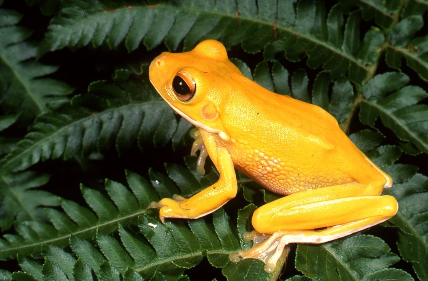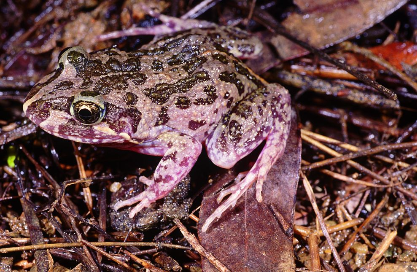


 As a region known for its extraordinary biodiversity, the Wet Tropics is especially rich in frog species. About 54 frog species occur in the Wet Tropics region as well as the introduced pest, the cane toad (Rhinella marina). There are about 212 frog species in Australia.
As a region known for its extraordinary biodiversity, the Wet Tropics is especially rich in frog species. About 54 frog species occur in the Wet Tropics region as well as the introduced pest, the cane toad (Rhinella marina). There are about 212 frog species in Australia.
However, Australia does not have any representatives of two of the world's three types of amphibians - nor does it have a naturally occurring toad. Amphibians consist of frogs and toads (called anurans), salamanders and caecilians (which resemble worms).
Amphibians get their name from their unique life cycle where they spend part of their life under water and another part of their life on land. The process by which they change from one type of animal (an aquatic one with gills) to another type (a terrestrial animal with lungs) is called metamorphosis. Children, especially, have always been fascinated with collecting tadpoles and watching them change into frogs.

In north Queensland, we have a range of frog types including tree frogs, mist frogs, burrowing frogs, water-holding frogs (which encase themselves in a 'plastic bag' during the dry season) and even frogs which do not have any aquatic tadpoles. Some frogs prefer the cooler climates of the high mountaintops in the World Heritage Area, while others can easily be found in humid lowland habitats such as wetlands, melaleuca (paperbark) swamps, flooded grasslands or cane fields, and fast flowing, rocky creeks. Some frogs don't mind suburbia and often take advantage of our lights to catch insects.
Frogs are a hot topic worldwide as many of them are becoming extinct. Fortunately, we have some species which are still relatively common and can be easily found in our suburbs or close by. If you want to know what frogs are in your yard, there are two ways to find out. One is to identify the frog by its call and the other is to find the frog and identify it by sight.
 A male frog uses a vocal sac to make sounds when he wants to advertise that he's ready to mate. These sounds enable the female to find him when she's ready. Frog calls create a risk for the male as well because the calls attract the sort of animals that would like to eat the frog such as snakes. Each species has a totally unique call and only the females of that species will respond to it. Even when the calls of two different species sound alike to us, they are actually at slightly different frequencies or pitches. Scientists use electronic testing equipment to create a sonogram of the calls and these sonograms show graphically the minute differences that are too subtle for our ears to distinguish.
A male frog uses a vocal sac to make sounds when he wants to advertise that he's ready to mate. These sounds enable the female to find him when she's ready. Frog calls create a risk for the male as well because the calls attract the sort of animals that would like to eat the frog such as snakes. Each species has a totally unique call and only the females of that species will respond to it. Even when the calls of two different species sound alike to us, they are actually at slightly different frequencies or pitches. Scientists use electronic testing equipment to create a sonogram of the calls and these sonograms show graphically the minute differences that are too subtle for our ears to distinguish.
If you want to learn the frog calls and identify your backyard frogs yourself, you can buy recorded frog calls. It's not hard to learn the frog calls - it's just like learning bird calls only there are fewer to remember.
Frog calls are a good way to identify the species but it's more fun to look for and find the frogs themselves! They are generally endearing animals which fascinate young and old alike. Some are tree dwellers, others burrow underground or in leaf litter, some hide under tree bark and others prefer to hang around sedges at the edges of dams - some are as close as your outdoor loo (bathroom) or drainpipe.


Frogs are often viewed as a barometer of the health of our ecosystems, being an essential part of the food chain and filling numerous habitat niches.
Unfortunately, many Wet Tropics frogs have been disappearing and no-one is entirely sure why. Chytrid fungus is an introduced disease that is thought to be killing upland frogs in cooler climates. There are also several other diseases that seem to be affecting frogs in the Wet Tropics.
To learn more about the many frogs we have in north Queensland and the threats to their survival, visit the following websites:
Or, you can download a factsheet or Tropical Topics:
You can download a list of frog species for the Wet Tropics bioregion sourced from the Queensland Government's WildNet database.